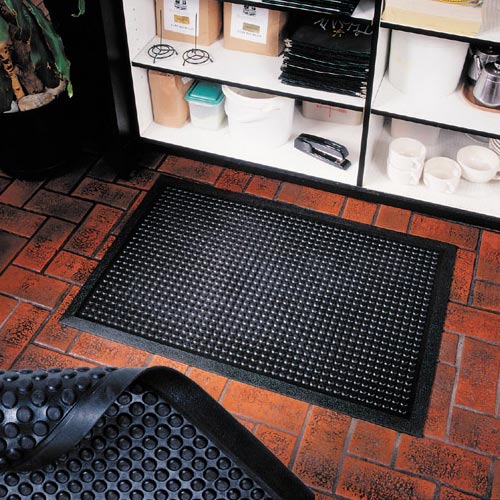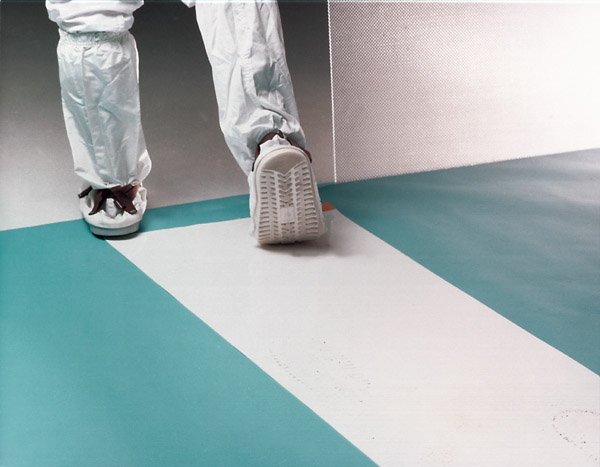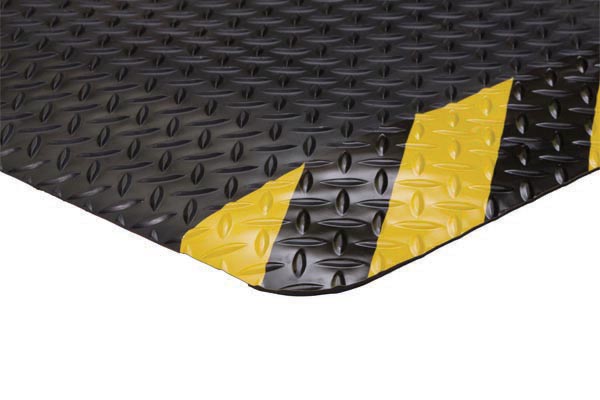Are Anti Fatigue Mats Worth It, Anti Fatigue Mats in the Workplace
Related Product: Bubble Trax Ultra Anti-Fatigue Mat 3/4 Inch 2x72 Ft.
The problem
Standing still for long periods on a hard surface, like a tile or concrete floor, is not an activity that our bodies are designed for. Our leg muscles tighten and constrict. Our hearts have to work harder to pump blood around and through these constricted muscles. And this extra work by our heart actually makes our whole body tired. And, don't forget about the foot, leg, and back pain that can also result from standing for hours on end.Unfortunately, that's not all - standing for long periods can cause a flattening of the foot, leading to arch and heel pain, and stagnating or pooling blood can cause varicose veins. Studies have indicated that people are more likely to have an accident when they are tired, fatigued or in pain - so anti fatigue mats can have a secondary safety effect as well.
Workers who are in pain are also less productive. A study in the Journal of American Medicine estimated that an average of 3.5 hours a week are lost due to reduced worker performance - that adds up to almost 23 days a year! This does not include days that result in absenteeism, nor does this take into account medical expenses or Worker's Compensation claims from muscular skeletal damage. Simply put, a tired worker or hobbyist is less productive, less happy and may have to see a doctor more often.
The solution
The solution lies in a simple anti fatigue mat. The softer surface of an anti-fatigue mat encourages subtle movement of the leg and foot muscles. As you shift around on the mat, this movement allows blood, and oxygen to flow more easily, and the heart does not have to pump as hard.In addition to an antifatigue mat, make sure you take breaks during the day. Walking to the bathroom, speaking to a coworker face to face rather than sending an email can give your body the break it needs to keep you happy, productive and injury free.
Where to use anti-fatigue mats
Household locations that can benefit from anti-fatigue mats are home kitchens and work benches, craft areas and work shops and laundry rooms. Anywhere that you stand for long periods of time. If you work at home, and use a stand up desk, an anti-fatigue mat is recommended.On the job, service desks, cashier and hostess stations, shipping and packing, wait stations, manufacturing, laboratories, assembly and picking stations, food service and parts counters are just some of the areas where employees would benefit from the use of anti-fatigue mats.
Keep anti-fatigue properties and intended use in mind
Choosing an anti-fatigue mat is one area where the lowest cost option is often not the best. Anti-fatigue mats are available at big box retailers, but it is worth doing some research with an online flooring specialist. Greatmats.com is one company that offers a range of choices for many budgets and purposes. Remember, cheaper mats tend to wear out more quickly, may offer only minimal anti-fatigue benefits, and may curl and bend to become a tripping hazard.Mats vary in size from a 2 foot by 3 foot to runners, to mats that curve around a salon chair, to perforated mats for wet areas like food prep areas and manufacturing.
Mats can be made from a variety of materials like vinyl, foam, rubber, and PVC and a combination of these materials.
As far as cushioning, softer is not always better. A mat should have a degree of rebound, where the surface returns to its original form after your weight is moved. A too-soft mat is like standing on a mattress - it takes more work to remain upright, which can also lead to fatigue.
Look for beveled edges to prevent tripping and allow carts to move onto the mat. Some mats have brightly-colored borders to increase safety awareness. Anti-fatigue mats can include additional features like anti-slip surfaces. Bubbleflex, Gridstep and Honeycomb are a few of the more popular options.
Some mats even have anti-static electricity properties to prevent damage to people and equipment in manufacturing and industrial work. ESD Static Dissipative Mats and Apachestat are some examples of this type of mat. The closed-cell foam mat offers comfort and relief to aching legs as well as an anti-slip surface. Some mats can also withstand welding. Weld Master and Stand-N-Weld are popular brands of anti-fatigue mats used in areas used for welding. Hog Heaven Indoor Anti Fatigue mats are designed to withstand welding sparks and slag up to 1,800 degrees.
In industrial areas where fluids like oil and grease are present, a draining rubber mat is the safest option. Vinyl cannot stand up to oil and grease. Industrial machining areas, where lots of metal shavings fall to the floor, would benefit from perforated mats as they will make cleanup easier. The drainage holes allow liquid and waste to pass through. Also, a sturdy rubber mat won't get metal shavings imbedded in its surface as easily as a softer mat.
Chemical-resistant mats, such as Dekplate, are another option. Hospitals and laboratories require anti microbial properties found in mats like K-Marble. Noise resistance is another optional feature, available from brands like Noyz Mats.
When you have narrowed your choices down to a few mats, check the warranty. Mats with a longer warranty usually last longer, because the manufacturer has designed them for long life. Warranties can range from several years to lifetime!
Whichever mat you choose, know that you are making an investment in your comfort, productivity and overall health.



